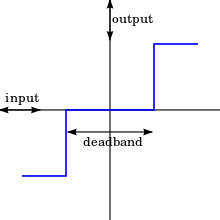Deadband

A deadband (sometimes called a neutral zone) is an interval of a signal domain or band where no action occurs (the system is dead). Deadband is used in voltage regulators and other controllers. The purpose is common, to prevent oscillation or repeated activation-deactivation cycles (called 'hunting' in proportional control systems).

Voltage regulators
In some substations there are regulators that keep the voltage within certain predetermined limits, but there is a range of voltage in-between during which no changes are made, such as, maybe, between 112 to 118 volts (deadband is 6 volts here), or 215 to 225 volts (deadband is 10 volts here).
Reference : Mohsin AL-Khamini
Backlash
Gear teeth with slop (backlash) exhibit deadband. There is no drive from the input to the output shaft in either direction while the teeth are not meshed. Leadscrews generally also have backlash and hence a deadband, which must be taken into account when making position adjustments, especially with CNC systems. If mechanical backlash eliminators are not available, the control can compensate for backlash by adding the deadband value to the position vector whenever direction is reversed.
Hysteresis Vs. Deadband
Deadband is different from hysteresis. With hysteresis there is no dead zone, and so the output is always in one direction or another. Devices with hysteresis have memory, in that previous system states dictate future states. Examples of devices with hysteresis are single-mode thermostats and smoke alarms.
Thermostats
Simple (single mode) thermostats exhibit hysteresis. The furnace in the basement of a house is adjusted automatically by the thermostat to be switched on as soon as the temperature at the thermostat falls to 18 °C, for example, and the furnace is switched off by the thermostat as soon as the temperature at the thermostat reaches 22 °C. There is no temperature at which the house is not being heated or allowed to cool (furnace on or off).
A thermostat which sets a single temperature and automatically controls both heating and cooling systems without a mode change exhibits a deadband range around the target temperature. The low end of the deadband is just above the temperature where the heating system turns on. The high end of the deadband is just below the temperature where the air-conditioning system starts.
Alarms
A smoke detector is also an example of hysteresis, not deadband. The smoke detector at the ceiling of the kitchen starts the alarm as soon as the level of smoke reaches a certain starting value, x, then the smoke detector stays in the alarm position until the level of smoke has been reduced to level y, after which the smoke detector is reset automatically to "normal". The hysteresis here is x minus y.
See also
References
- Johnson, Curtis D. "Process Control Instrumentation Technology", Prentice Hall (2002, 7th ed.)
- "Dead Band Plus Hysteresis Estimation with ValveLink Diagnostics" (PDF). Product Bulletin. Fisher Controls International. October 2012. Retrieved 18 January 2013.
- Murty, D.V.S. (2009). Transducers & Instrumentation (2nd ed.). New Delhi: Prentice-Hall of India. pp. 15–16. ISBN 978-8120335691. Retrieved 18 January 2013.
- Postlethwaite, Bruce. "On-Off Control". Introduction to Process Control. Department of Chemical and Process Engineering, University of Strathclyde. Retrieved 18 January 2013.